Last week CDFA announced the lifting of a long-running quarantine in California for the European Grapevine Moth, dating back to 2009. In the midst of the program, in 2012, CDFA produced a video featuring Napa County Agriculture Commissioner (then asst.) Greg Clark discussing the effectiveness of moth pheromone for mating disruption. It was a major part of the eradication program.
-
Recent Posts
- CDFA’s Progress for Californians — the vast reach of Farm to School
- CDFA congratulates staff for completing coaching program — an important step in developing leadership skills
- Join Secretary Ross in celebrating Public Service Recognition Week 2025
- Secretary Ross in the Central Valley — a new dairy processing plant; honoring a long-time colleague; and a vital discussion on immigration
- California Milk and Dairy Products: Safety You Can Rely On, Thanks to CDFA
Recent Comments
- Stacy Hackney on Despite Tariffs, California Continues Trade Engagement
- Keshav Boddula on Earth Week spotlight — CDFA Food Recovery webpage offers resources for reducing food waste
- Don’t Worry, US Investors Can Still Make Offshore Wind Happen … Somewhere – Bruce Beach CA News on California Peaches and Nectarines Arrive in Vietnam! New Export Market Opens for California Products
- US Investors Can Still Make Offshore Wind Happen…In Vietnam - Oilandinvest.com on California Peaches and Nectarines Arrive in Vietnam! New Export Market Opens for California Products
- US Investors Can Still Make Offshore Wind Happen…In Vietnam - nrinvesting.com on California Peaches and Nectarines Arrive in Vietnam! New Export Market Opens for California Products
Archives
- May 2025
- April 2025
- March 2025
- February 2025
- January 2025
- December 2024
- November 2024
- October 2024
- September 2024
- August 2024
- July 2024
- June 2024
- May 2024
- April 2024
- March 2024
- February 2024
- January 2024
- December 2023
- November 2023
- October 2023
- September 2023
- August 2023
- July 2023
- June 2023
- May 2023
- April 2023
- March 2023
- February 2023
- January 2023
- December 2022
- November 2022
- October 2022
- September 2022
- August 2022
- July 2022
- June 2022
- May 2022
- April 2022
- March 2022
- February 2022
- January 2022
- December 2021
- November 2021
- October 2021
- September 2021
- August 2021
- July 2021
- June 2021
- May 2021
- April 2021
- March 2021
- February 2021
- January 2021
- December 2020
- November 2020
- October 2020
- September 2020
- August 2020
- July 2020
- June 2020
- May 2020
- April 2020
- March 2020
- February 2020
- January 2020
- December 2019
- November 2019
- October 2019
- September 2019
- August 2019
- July 2019
- June 2019
- May 2019
- April 2019
- March 2019
- February 2019
- January 2019
- December 2018
- November 2018
- October 2018
- September 2018
- August 2018
- July 2018
- June 2018
- May 2018
- April 2018
- March 2018
- February 2018
- January 2018
- December 2017
- November 2017
- October 2017
- September 2017
- August 2017
- July 2017
- June 2017
- May 2017
- April 2017
- March 2017
- February 2017
- January 2017
- December 2016
- November 2016
- October 2016
- September 2016
- August 2016
- July 2016
- June 2016
- May 2016
- April 2016
- March 2016
- February 2016
- January 2016
- December 2015
- November 2015
- October 2015
- September 2015
- August 2015
- July 2015
- June 2015
- May 2015
- April 2015
- March 2015
- February 2015
- January 2015
- December 2014
- November 2014
- October 2014
- September 2014
- August 2014
- July 2014
- June 2014
- May 2014
- April 2014
- March 2014
- February 2014
- January 2014
- December 2013
- November 2013
- October 2013
- September 2013
- August 2013
- July 2013
- June 2013
- May 2013
- April 2013
- March 2013
- February 2013
- January 2013
- December 2012
- November 2012
- October 2012
- September 2012
- August 2012
- July 2012
- June 2012
- May 2012
- April 2012
- March 2012
- February 2012
- January 2012
- December 2011
- November 2011
- October 2011
- September 2011
- August 2011
- July 2011
- June 2011
Categories
- AG Vision
- Agricultural Education
- Agricultural Marketing
- Alternative Fuels
- Animal health
- Animal Welfare
- Asian Citrus Psyllid
- Biodiversity
- Border stations
- BSE
- Cannabis
- Cannella Panel
- Climate Change
- Climate Smart Agriculture
- Community-based Food System
- Conservation
- Dairy
- Drought
- Environment
- Fairs
- Farm Bill
- Farm Labor
- Farmers' Markets
- Fertilizer
- Food Access
- Food Safety
- Food Waste
- Glassy-winged Sharpshooter
- Growing California
- Healthy soils
- HLB
- Hydrogen
- Integrated Pest Management (IPM)
- Invasive Species
- Light Brown Apple Moth
- Livestock ID
- Measurement Standards
- Nutrition
- Organic agriculture
- Pierce's Disease
- Pollinators
- Specialty Crops
- State Board of Food and Agriculture
- Succession Planning
- Trade
- Uncategorized
Pages
RSS














